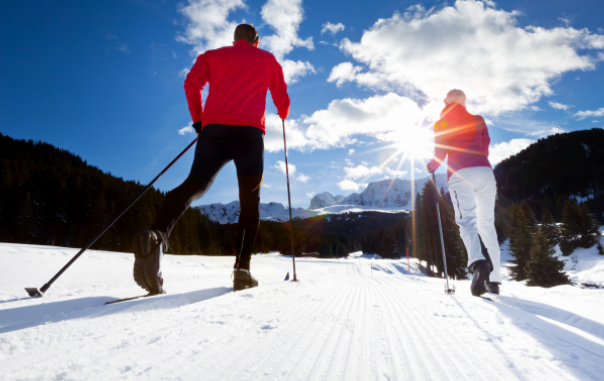
This will be the winter for outdoor sports and activity! Outside activity will be more popular than ever this year as public health authorities continue to promote a lower risk of COVID virus transmission in the outdoors (with proper physical distancing measures of course!).
Cross-country skiing is a popular winter sport and recreational activity done in a snowy climate. Differing from downhill skiing both by its technique and by its equipment, cross-country skiing involves traversing long stretches of flat snow or gentle slopes. Frequently used in the military, as well, for winter warfare exercises and training events in northern territories, it often comes with a steep learning curve for beginners and can be a tough sport to get into if you do not know where to begin or how to train.
Beginners should start by learning the classic technique. Classic cross-country skiing uses a kicking and gliding motion as you lean slightly forward. You probably would not start alpine skiing without taking a lesson first, or lace up some ice skates and start playing hockey without learning to skate first, so why would cross-country skiing be any different? Consider purchasing a few lessons from a qualified instructor at a local ski centre to learn the basics in how to stand, how to move and how to stop
properly. Whether new to the sport or a seasoned veteran, strength endurance training indoors will also benefit your technique outdoors.
What muscles should you be working? What movement patterns will benefit your ski technique the most? Skiing requires repetitive muscular contractions, so aiming for a higher rep count and a lower resistance will be key in your training plan. Let’s explore some movement patterns and the muscles that perform the movements, so you can get an idea of what to do at the gym to strengthen those specific muscles and improve your technique.
Deadlift. This exercise engages the hamstrings and quadriceps of the thighs, the gluteals of the hip and butt and the erector spinae of the back. These powerful muscles help drive the body forward during the push phase of skiing while also supporting the body in the forward lean position skiing.
Split Squat/Lunge/Rear Foot Elevated Lunge. These exercises targets the quads and gluteals similar to the deadlift, but in a single-leg fashion similar to the single-leg push off in cross-country skiing. It is also great for working on balance, a key skill in skiing. Progress to the appropriate level.
Triceps push-down/extension. This exercise targets the triceps muscles of the arms and the latissimus dorsi of the back. These muscles are active during the polling motion of skiing and is a great way to build strength for the push phase.
Pull-Ups/Chin-Ups. Another great upper body option for the arms, back and latissimus dorsi. Benefits would be the same as the Triceps push/downs listed above. This is a more advanced exercise, so proceed at your own level.
Plank. This exercise engages many muscles, but most importantly, the rectus abdominis muscles of the abdomen. The abdominal muscles along with the erector spinae muscles of the back help to keep your body stable while skiing. The stronger the core, the more capable it is at providing you with stability.
Armed with your new found knowledge, it’s time for you to get outside and enjoy the snowy winter weather and all the health and fitness benefits winter sports have to offer. And, what better way to do that than join the CFB Kingston Winter Activity Challenge! Track your activity minutes as you make your way virtually to the North Pole. Registration is free and there is prizing to be won! To find out more or to register, go to: https://raceroster.com/events/2021/35690/cfb-kingston-winter-activity-challenge-2021?locale=en_US
Article by: Janice Keown, BSc. Kin. CSEP-CPT, ACSM EP-C, Fitness and Sports Instructor, CFB Kingston Personnel Support Programs
